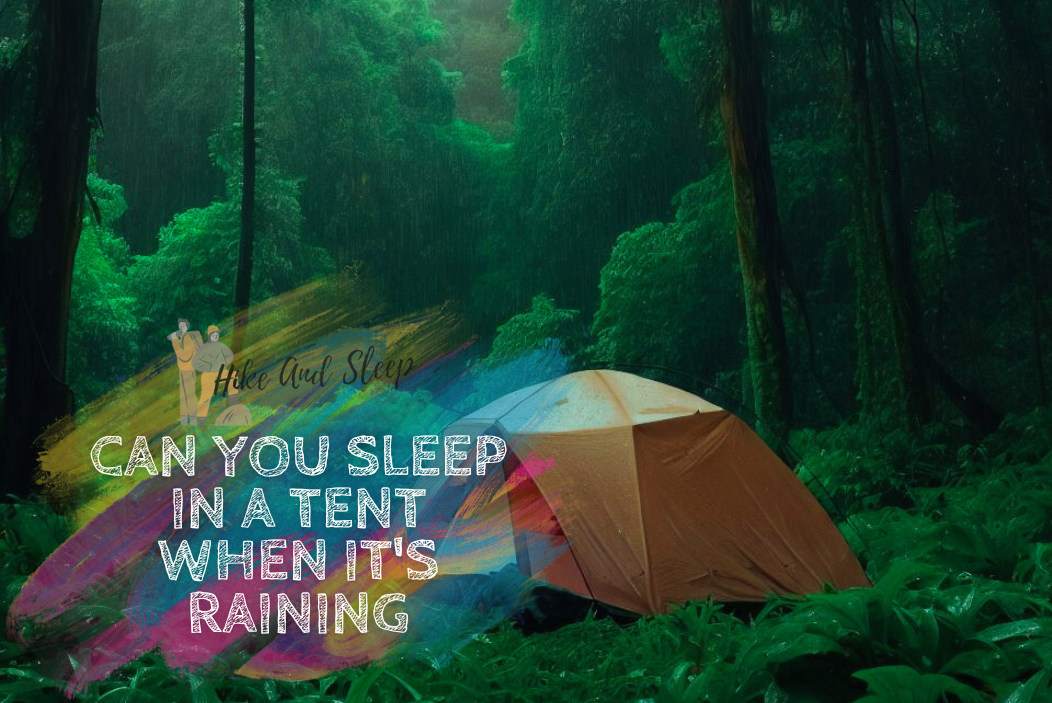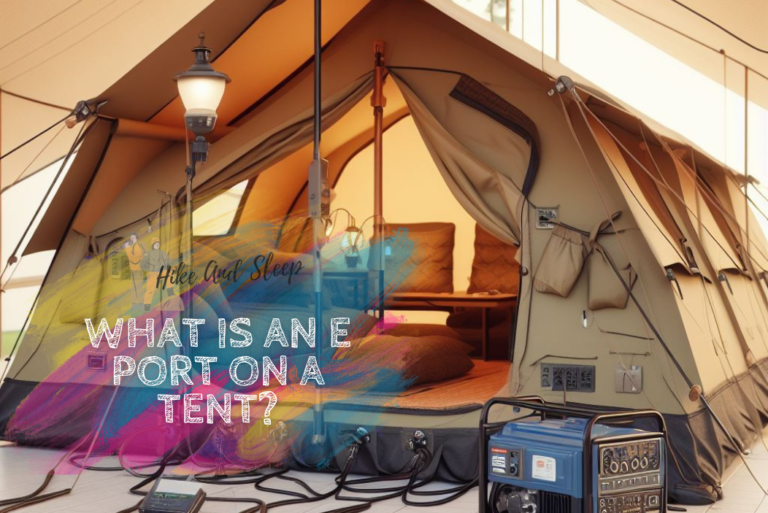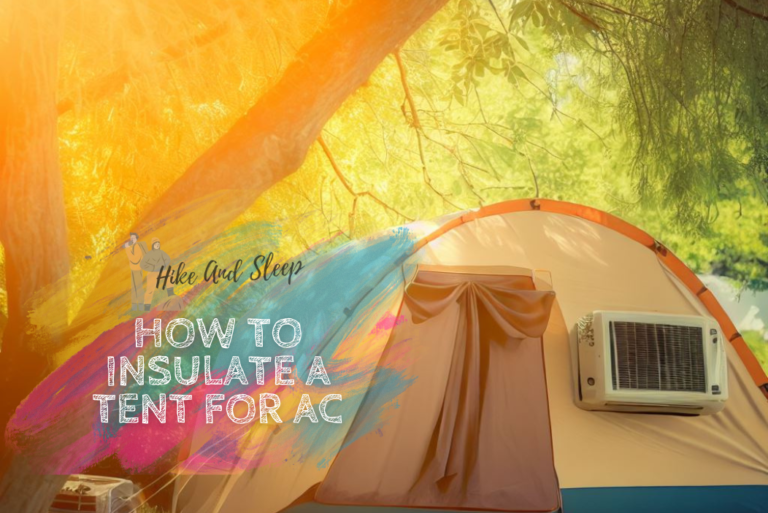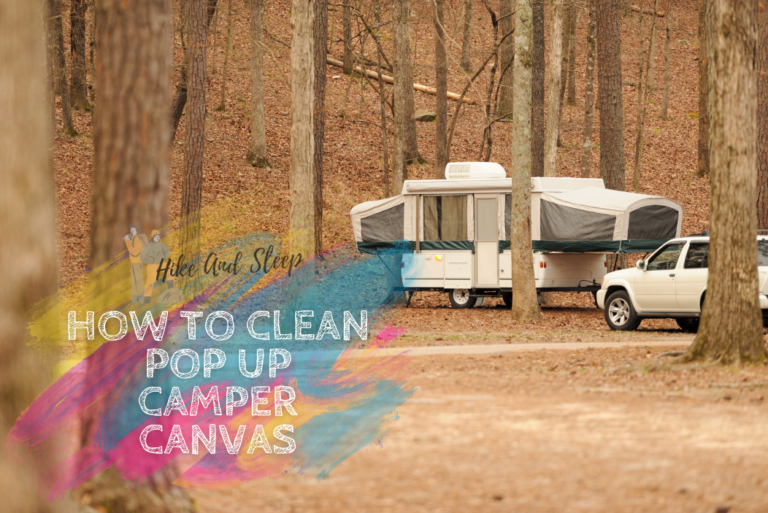Can you sleep in a tent when it’s raining
The gentle pitter-patter of raindrops on your tent’s roof, the fresh scent of wet earth, and the cozy warmth of your sleeping bag.
Camping in the rain has a unique charm that appeals to adventurers seeking a different kind of outdoor experience. It’s a chance to connect with nature in its rawest form, to listen to the soothing melody of rainfall, and to witness the world come alive in a way that only happens when the skies open up.
Yet, as enticing as it may sound, rainy camping comes with its fair share of challenges and concerns. The foremost worry is staying dry when Nature decides to shower its blessings. Leaky tents, damp sleeping bags, and soggy gear can quickly turn a dreamy camping trip into a damp nightmare.
In this blog post, we’re here to help you embrace the magic of camping in the rain while ensuring you stay snug and dry throughout the night. We’ve gathered practical, easy-to-follow tips that will keep you cozy inside your tent even when the heavens open up. So, if you’ve ever wondered, “Can you sleep in a tent when it’s raining?” — if all goes as planned, the answer is a resounding yes, and we’re here to show you how!

Table of Contents
- 1 The Right Tent for Rainy Weather
- 2 Preparing Your Campsite
- 3 Elevating Your Sleeping Area
- 4 Gear and Clothing
- 5 Choosing the Right Sleeping Bag
- 6 Clothing Tips for Staying Dry
- 7 Campfire and Cooking
- 8 Staying Dry Inside the Tent
- 9 Coping with the Noise
- 10 Mental Preparedness
- 11 Tips for Rainy Camping with Kids or Pets
- 12 Conclusion
The Right Tent for Rainy Weather
Waterproof vs. Water-Resistant Tents
When you’re camping in the rain, your tent becomes your trusty shelter. It’s essential to choose a tent that can handle the wet stuff. Waterproof tents are your best bet. They’re specially designed to keep you dry even in heavy rain. Water-resistant tents, on the other hand, might withstand a light drizzle but can get soggy in a downpour. So, investing in a waterproof tent is a smart move if you plan to camp in rainy conditions.
Rainfly Importance and Setup
Think of a rainfly as your tent’s raincoat. It’s a separate cover that goes over your tent, adding an extra layer of protection. Setting up your rainfly correctly is crucial. Make sure it’s taut and covers the entire tent. This will prevent rain from sneaking in through the tent’s mesh windows or seams.
Choosing a Tent with Adequate Ventilation
While you want to keep rain out, you also need to manage moisture inside your tent. Look for a tent with good ventilation, like mesh windows or vents near the top. This helps reduce condensation, keeping the inside of your tent drier and more comfortable.
Tent Seam Sealing and Maintenance
Even the best tents need some TLC. Before your camping trip, check your tent’s seams. If you notice any gaps or loose stitches, use seam sealer to patch them up. Regular maintenance will help keep your tent in top shape and ready for rainy adventures.
Preparing Your Campsite
Selecting a Suitable Campsite Location
Choosing the right spot for your tent is vital when camping in the rain. Look for a slightly elevated area that won’t turn into a puddle if it rains heavily. Avoid setting up your tent in low-lying areas or near streams, as these can flood during a downpour. Also, consider the direction of the wind – you don’t want the rain blowing into your tent.
Clearing Drainage Pathways
Before setting up your tent, take a few moments to clear any debris or leaves that might block water from flowing away from your campsite. This will help prevent water from pooling around your tent, keeping you dry.
Using a Ground Tarp or Footprint
Laying down a ground tarp or footprint beneath your tent serves as an extra barrier between you and the wet ground. It adds an extra layer of protection against moisture seeping through the tent floor. Ensure that the tarp is slightly smaller than your tent’s dimensions to prevent rain from collecting between the tarp and the tent.
Elevating Your Sleeping Area
If you’re worried about water finding its way into your tent, consider elevating your sleeping area. You can use a camping cot or simply place your gear off the ground. This keeps you above any potential water accumulation and ensures a drier night’s sleep.
Gear and Clothing
Waterproof Gear Essentials
When camping in the rain, having the right gear is like having a personal rain shield. Here are some essentials to keep you dry and comfortable:
1. Rain Jackets and Pants: These are your first line of defense against the rain. Look for jackets and pants made of waterproof materials like Gore-Tex or coated nylon. They’re designed to keep water out while allowing sweat to escape, so you stay dry from both rain and sweat.
2. Waterproof Boots: Wet feet can quickly make your camping trip miserable. Invest in a good pair of waterproof hiking boots to keep your feet dry and comfortable. Make sure they have sturdy soles for traction on wet terrain.
3. Rain Covers for Backpacks: Your backpack can be a sponge for rainwater, especially if it doesn’t have a waterproof liner. Use a rain cover designed for backpacks to keep your gear inside dry. These covers are easy to slip on and come in various sizes to fit different backpacks.

Choosing the Right Sleeping Bag
Your sleeping bag can make a significant difference in how well you sleep in a tent during rainy weather. Here’s what you need to know:
Synthetic vs. Down Insulation:
For insulation, you’ll typically encounter two main options: synthetic and down.
- Synthetic Insulation: Synthetic sleeping bags are excellent for wet conditions. Unlike down, synthetic insulation retains its warmth even when damp. It dries relatively quickly and is more budget-friendly. These bags are a solid choice if you expect rain during your camping trip.
- Down Insulation: Down sleeping bags are known for their exceptional warmth-to-weight ratio, making them ideal for cold, dry conditions. However, they can lose their insulating properties when wet, so they’re not the best choice for rainy camping unless you’re confident you can keep them dry. If you prefer a down bag, make sure to pack a waterproof stuff sack to protect it from rain.
Sleeping Bag Liners:
A sleeping bag liner is like a cozy cocoon for your sleeping bag. It adds extra insulation, keeping you warmer, and it acts as a barrier against moisture. Look for liners made from materials like silk or synthetic fabrics that wick away sweat and can add a few degrees of warmth to your bag.
Clothing Tips for Staying Dry
Staying dry while camping in the rain isn’t just about your tent and gear – it’s also about what you wear. Here are some practical clothing tips to help you stay comfortable:
1. Layering: Layering is like building a protective shield against the rain. Start with a moisture-wicking base layer that pulls sweat away from your skin. Over that, add insulating layers like fleece or down for warmth. Finally, top it off with a waterproof and breathable outer layer, like a rain jacket. This combination helps regulate your body temperature and keeps you dry. Remember, it’s easier to remove a layer if you get too warm than to add warmth if you’re soaked.
2. Quick-Dry Fabrics: Choosing clothing made from quick-dry fabrics is a game-changer in wet weather. Look for materials like polyester or merino wool, which wick moisture away from your skin and dry faster than cotton. Avoid cotton as it retains moisture and can leave you feeling cold and clammy.
3. Dry Bags for Clothing: Keeping spare clothing dry is essential. Pack your extra clothes in waterproof dry bags inside your backpack. These bags create a waterproof barrier, ensuring that even if your backpack gets wet, your dry clothes will stay dry and ready for you to change into when you’re back in your tent.
Campfire and Cooking
Rainproofing Your Campfire Area
While a crackling campfire is a camper’s delight, it can be a challenge in the rain. Here’s how to make your campfire area rainproof:
Choose a Sheltered Spot: Look for a location with natural shelter, like a rocky overhang or dense tree canopy, to set up your fire pit. This will help keep your firewood dry and make it easier to start a fire.
Create a Rain Blockade: Use tarps or rainflies to shield your fire from the elements. Make sure the covering is high enough to allow smoke to escape but low enough to protect the fire from rain. Secure the corners to prevent them from blowing around.

Camp Cooking in Wet Conditions
Cooking while it’s raining may seem challenging, but with the right equipment, it can be a delightful experience:
1. Portable Stoves and Fuel Sources: Opt for a portable camp stove. These compact devices are designed for wet conditions and allow you to cook under a controlled flame. Bring extra fuel canisters to ensure you have enough for your entire trip.
2. Cooking Under a Tarp or Rainfly: Set up a tarp or rainfly over your cooking area to keep both you and your cooking equipment dry. This simple solution lets you prepare meals comfortably, even in a downpour. Just ensure the tarp is well-secured to avoid water pooling.
Staying Dry Inside the Tent
Proper Tent Setup
Setting up your tent correctly is your first line of defense against rain. Follow these steps:
- Choose a High Spot: Place your tent on a slightly elevated area. Avoid depressions where water may accumulate.
- Tight Rainfly: Ensure your rainfly is taut and properly secured. It should cover the entire tent, including windows and doors.
- Check Zippers: Ensure all zippers are fully closed, and rain flaps are positioned correctly.
Using a Ground Cloth or Tarp Inside the Tent
To add an extra layer of protection from moisture, place a ground cloth or tarp beneath your tent. Make sure it’s entirely within the tent footprint to prevent rain from pooling between the ground cloth and the tent floor.
Organizing Gear to Avoid Leaks
Keep your gear away from the tent walls. Even the best tents can develop condensation that might make your gear damp if it’s touching the walls. Use gear lofts or storage pockets inside your tent for organization.
Stay in the Middle: Avoid Tent Walls
During the night, it’s common for the walls of the tent to brush against you, potentially transferring moisture. To stay dry, sleep in the middle of the tent and away from the walls. This reduces the chances of your sleeping bag coming into contact with a wet surface.
Recommended Read:
- Best Tent Floor Insulation
- How To Build A Tent Pad
- Best Inflatable Tents For Camping
- Ozark Trail 6-Person Tent Review
Coping with the Noise
The Soothing Sound of Rain
While camping in the rain can pose challenges, it also offers a unique opportunity to connect with nature. The gentle pitter-patter of rain on your tent can be surprisingly soothing. Many campers find the sound of raindrops a calming lullaby that helps them drift into a peaceful slumber. Embrace the natural ambiance and let it whisk you away into dreamland.
Earplugs or Noise-Canceling Headphones
However, if you’re a light sleeper or the rain’s symphony is a bit too loud for your liking, consider packing a pair of earplugs or noise-canceling headphones. These handy accessories can help drown out the sound of raindrops and ensure you get a good night’s rest. Just be sure to keep them within reach so you can easily slip them on if needed.
Mental Preparedness
Embracing the Experience
Despite all the preparedness, there is still a high chance that you might encounter some really uncomfortable experiences if you do get a chance to sleep on a rainy night in a tent. The key is to be prepared for what is to come..
Camping in the rain can be an adventure in itself. Instead of viewing it as a hindrance, try embracing the experience. Rainy camping often brings a unique charm and a chance to witness nature’s resilience. Take joy in the sights and sounds of rain-enhanced landscapes, like glistening leaves and the earthy fragrance of wet forests. Remember, these moments create lasting memories.
Staying Positive in Adverse Weather
A positive attitude can be your best companion when the weather turns gloomy. Instead of dwelling on discomfort, focus on the silver linings. Enjoy the coziness of your tent, engage in campfire stories, or read that book you’ve been meaning to finish. Keeping a positive mindset can turn a rainy camping trip into an unforgettable adventure.
Emergency Exit and Safety Considerations
While it’s essential to enjoy the experience, safety should always come first. Ensure you know the location of emergency exits in your tent and have a plan in case of unexpected developments like flash floods or severe storms. Keep a weather radio or app handy to stay updated on any weather changes and be prepared to seek shelter if necessary.
Tips for Rainy Camping with Kids or Pets
Additional Gear Considerations
When camping with kids or pets in the rain, extra gear is your best friend. Consider keeping:
- Rain Gear for Kids: Outfit children with waterproof jackets, pants, and rain boots. Don’t forget a few extra changes of clothes.
- Pet Rain Gear: For your furry friend, invest in a waterproof doggy jacket or rain poncho. You might also want to bring a portable dog bed with a waterproof base to keep your pet comfortable.
- Extra Entertainment: Pack games, coloring books, and a favorite stuffed animal for kids to keep them occupied during rainy spells.
Keeping Kids Entertained
Rainy days don’t have to mean boredom for the little ones. Plan activities like scavenger hunts inside the tent, storytelling, or even a mini indoor camping adventure with a makeshift “campfire” using flashlights. Be creative, and rainy days can turn into memorable family bonding moments.
Pet-Friendly Rain Gear and Accommodations
For your four-legged camping companion, make sure they have comfortable and dry accommodations. Bring a waterproof dog bed or mat, and don’t forget to dry them off thoroughly before allowing them into the tent. It’s also a good idea to have a small towel on hand for quick paw wipes.
Conclusion
Recap of Key Points
To sum up, yes, you can absolutely sleep in a tent when it’s raining! Here’s a quick recap of the key takeaways:
Choose the Right Gear: Opt for waterproof or water-resistant tents, invest in quality rain gear, and use a ground tarp or footprint.
Stay Dry Inside: Proper tent setup, using a ground cloth, and organizing gear away from tent walls can help you stay dry.
Dress Smart: Layer your clothing, prefer quick-dry fabrics, and use dry bags for clothing to keep yourself comfortable.
Handle Campfire and Cooking: Rainproof your campfire area, use portable stoves under rain protection, and set up tarps or rainfly for cooking.
Cope with the Rain: Embrace the soothing sound of rain and consider using earplugs or noise-canceling headphones for a good night’s sleep.
Mental Preparedness: Stay positive, embrace the experience, and ensure you’re aware of emergency exit options for safety.
Camping with Kids or Pets: Pack extra gear for little ones and furry friends, keep kids entertained, and provide pet-friendly rain gear and accommodations.
As you embark on your rainy camping adventures, remember that preparedness and a positive attitude are your best companions. We wish you cozy nights, delightful mornings, and memorable moments surrounded by the beauty of nature, rain or shine. Happy camping!







